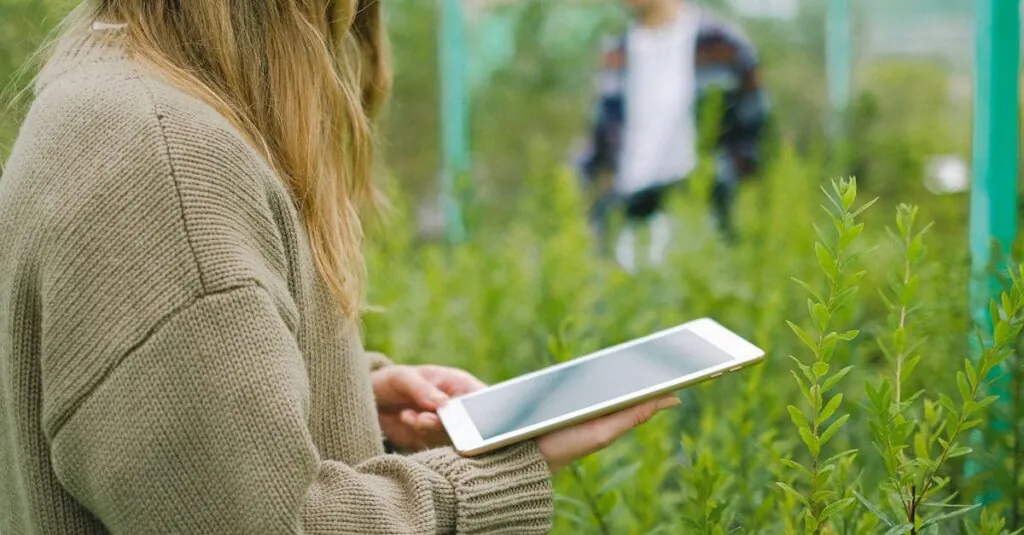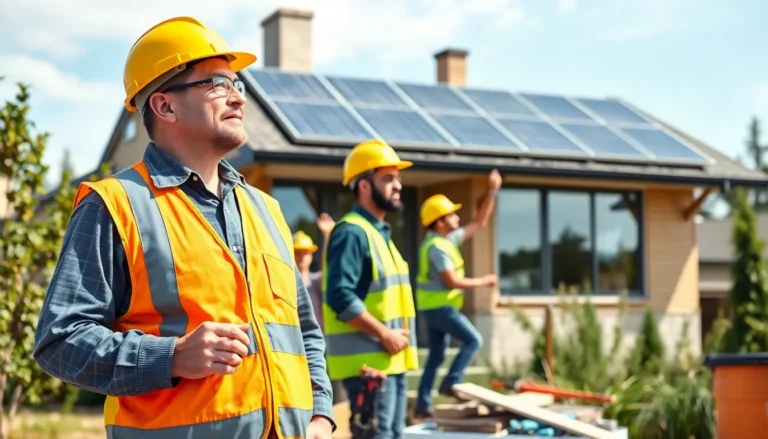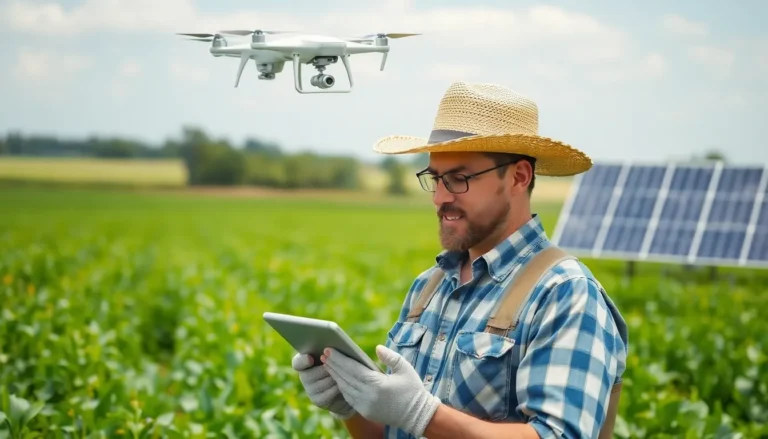Table of Contents
ToggleIn a world where plants can be more tech-savvy than some humans, smart agriculture is revolutionizing the way we grow food. Imagine crops that can text their farmers when they’re thirsty or drones that can spot pests faster than a hawk on a mission. It’s not just sci-fi; it’s the future of farming.
What Is Smart Agriculture?
Smart agriculture represents a blend of advanced technology and traditional farming practices. This approach utilizes tools such as sensors, GPS, and data analytics to enhance productivity. Technologies enable real-time monitoring of crops, allowing farmers to make informed decisions based on accurate data.
Sensors placed in the field measure soil moisture and nutrient levels. These devices transmit information that helps farmers determine optimal watering and fertilization schedules. Automated irrigation systems respond to this data, ensuring crops receive the necessary resources without waste.
Drones play a significant role in pest management. Equipped with cameras and imaging technology, drones survey large areas quickly. Farmers receive alerts regarding pest infestations, enabling prompt intervention to protect crops.
Robotics also contribute to smart agriculture’s success. Autonomous tractors and harvesters perform labor-intensive tasks efficiently. By reducing labor requirements, these machines increase overall productivity and lower costs.
Data analytics and machine learning provide deeper insights. Historical data combined with current conditions allows for predictive modeling. Farmers can evaluate potential outcomes, adjusting their strategies to maximize yield and minimize risks.
Overall, smart agriculture revolutionizes food production through technology integration. By enabling precise monitoring and management, this innovative approach helps ensure sustainable farming and food security for the growing global population.
Benefits of Smart Agriculture
Smart agriculture enhances food production through advanced technologies. These innovations deliver multiple benefits that contribute to sustainable farming practices.
Increased Efficiency
Increased efficiency emerges from the integration of real-time monitoring systems. Farmers gain immediate insights into crop conditions, allowing timely interventions based on precise data. Drones conduct aerial surveys and identify issues like pest infestations, significantly reducing the time spent on field evaluations. Autonomous equipment, such as tractors, perform tasks with minimal human intervention, resulting in higher productivity. Studies show that farms employing smart technology report yield improvements of up to 30 percent. Predictive analytics enable farmers to adjust their strategies proactively, addressing potential problems before they escalate. Overall, smart agriculture allows for streamlined operations, enhancing performance at all levels of production.
Resource Management
Effective resource management characterizes smart agriculture by utilizing data-driven methods. Sensors monitor soil moisture levels and nutrient availability, ensuring that resources match plant needs. This targeted approach minimizes waste, decreasing water usage by approximately 40 percent in many cases. Automated irrigation systems activate based on real-time data, promoting optimal conditions for growth while conserving water. Fertilizer application benefits similarly, as farmers can apply nutrients only where necessary, reducing runoff and environmental impact. Utilizing drones for field assessments also maximizes resource allocation, allowing adjustments tailored to specific crop requirements. Smart agriculture not only safeguards resources but also supports more sustainable farming practices, addressing current global challenges.
Technologies Used in Smart Agriculture
Smart agriculture employs various advanced technologies to optimize farming practices and increase productivity.
IoT and Sensors
The Internet of Things (IoT) plays a crucial role in smart agriculture by enabling real-time monitoring of crop conditions. Sensors measure soil moisture, temperature, and nutrient levels, providing immediate feedback to farmers. This system helps pinpoint precise watering and fertilization needs, ensuring resources get applied only where necessary. Moreover, IoT devices can send alerts directly to smartphones, allowing for timely interventions when crop conditions change. Implementing these technologies results in a significant reduction in water usage by around 40 percent, promoting sustainable practices.
Drones and UAVs
Drones and Unmanned Aerial Vehicles (UAVs) revolutionize crop management by enabling efficient surveying of large areas. Equipped with high-resolution cameras, drones capture detailed images that assist in identifying pest infestations and assessing crop health. Farmers can analyze this data swiftly, allowing for prompt pest management tactics. Additionally, aerial maps created through drone imagery help in planning irrigation and other agricultural activities. Utilizing drones can lead to improved insights and targeted interventions, ultimately boosting overall farm productivity.
Artificial Intelligence and Machine Learning
Artificial Intelligence (AI) and Machine Learning (ML) provide deeper insights into agricultural practices through predictive modeling. By analyzing vast amounts of data, these technologies enable farmers to anticipate challenges and optimize yield potential. Adjustments in planting strategies, crop rotation, and resource allocation become more data-driven with AI applications. Machine learning algorithms help refine these strategies continuously based on past performance and real-time data. As a result, farms leveraging AI can experience yield increases of up to 30 percent, demonstrating the transformative potential of these technologies in agriculture.
Challenges in Implementing Smart Agriculture
Smart agriculture faces several challenges that can hinder its widespread adoption and effectiveness.
Cost of Technology
Implementing smart agriculture often requires significant investment in technology. Advanced tools such as sensors, drones, and IoT systems can be expensive, limiting access for small-scale farmers. Farmers may find the initial costs daunting, especially given budget constraints. Long-term financial benefits exist, but upfront expenses often delay adoption. Adoption of these technologies may also necessitate additional training, further elevating costs. Despite these obstacles, government grants and subsidies can help alleviate financial burdens for farmers.
Data Management and Security
Effective data management remains a challenge in smart agriculture. Farmers must navigate vast amounts of information generated by sensors and systems, which can be overwhelming. Security concerns about data breaches and cybersecurity threats further complicate issues. Protecting sensitive agricultural data from unauthorized access is critical to preserving farmers’ privacy. Robust protocols and encryption are essential to combat these risks. Training for data management and cybersecurity is necessary to ensure farmers can effectively handle and protect their information.
Future of Smart Agriculture
The future of smart agriculture looks promising, with ongoing advancements in technology driving transformation. Innovative solutions like precision farming enhance crop health and yield. Sensors continuously monitor soil conditions and relay critical data to farmers, allowing for timely interventions.
Development in AI and machine learning is revolutionizing decision-making processes. By analyzing historical and real-time data, these technologies enable farmers to predict weather patterns and optimize planting schedules, improving crop resilience. Autonomous machinery streamlines labor-intensive tasks, reducing the need for human intervention.
Real-time data analytics empowers farmers by providing actionable insights. Farmers using smart agriculture tools can significantly reduce water usage, with studies showing reductions of about 40 percent through targeted irrigation methods. Efficient resource management allows producers to allocate inputs precisely where needed.
Drones contribute to precision agriculture by facilitating aerial surveys of fields. These devices identify pest infestations and monitor crop health, which enhances overall management strategies. Deploying UAVs leads to improved yields, with some farms experiencing enhancements of up to 30 percent.
Challenges persist in the implementation of smart agriculture. High initial costs deter some farmers from adopting new technologies. Small-scale farmers especially face hurdles in affording equipment like sensors and drones, despite the long-term benefits. Data management issues also require attention, as the amount of generated data increases.
Government initiatives play a crucial role in supporting farmers through grants and subsidies. By easing financial burdens, these programs can help accelerate the adoption of innovative practices. As smart agriculture continues to evolve, it holds the potential to significantly impact global food production and sustainability.
Smart agriculture is changing the landscape of farming by integrating cutting-edge technology with traditional practices. The benefits of increased efficiency and improved resource management are becoming evident as farmers embrace these innovations. With real-time data and automation, they can optimize crop yields while minimizing environmental impact.
Despite the challenges of initial costs and data management, the future looks bright. Ongoing advancements in AI, drones, and IoT are paving the way for more sustainable farming practices. As support from government initiatives continues, farmers are likely to overcome obstacles and fully harness the potential of smart agriculture. This evolution not only addresses food security but also promotes a more sustainable approach to feeding the growing global population.







